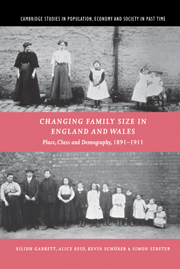Book contents
- Frontmatter
- Contents
- List of figures
- List of tables
- Preface and acknowledgements
- 1 Introduction
- 2 Locations for study
- 3 Studying locations
- 4 Infant and child mortality from the 1911 census
- 5 Fertility and fertility behaviour 1891–1911
- 6 The national picture
- 7 Class, place and demography: the mosaic of demographic change in England and Wales from Waterloo to the Great War
- Appendices
- A The indirect estimation of infant and child mortality and related applications
- B Choice of regression method
- C The values of community-level variables for each sector
- D The percentage of the population of each county living in each type of place, subdivided by envir onment, England and Wales, 1921
- References
- Index
- Cambridge Studies in Population, Economy and Society in Past Time
B - Choice of regression method
Published online by Cambridge University Press: 05 January 2010
- Frontmatter
- Contents
- List of figures
- List of tables
- Preface and acknowledgements
- 1 Introduction
- 2 Locations for study
- 3 Studying locations
- 4 Infant and child mortality from the 1911 census
- 5 Fertility and fertility behaviour 1891–1911
- 6 The national picture
- 7 Class, place and demography: the mosaic of demographic change in England and Wales from Waterloo to the Great War
- Appendices
- A The indirect estimation of infant and child mortality and related applications
- B Choice of regression method
- C The values of community-level variables for each sector
- D The percentage of the population of each county living in each type of place, subdivided by envir onment, England and Wales, 1921
- References
- Index
- Cambridge Studies in Population, Economy and Society in Past Time
Summary
The ordinary least squares (OLS) method of multiple regression modelling is used here, although for the statistically minded it is worth noting that the mortality index that we are using as the dependent variable can never be negative, and this may render simple OLS regression unsuitable as dependent variables are assumed to vary between negative and positive infinity. In practice, there may also be a large grouping of values of the mortality index on zero, as a considerable proportion of women will not have experienced any child deaths. This may make a tobit regression more suitable. Trussell and Preston, however, present a thorough comparison of the use of OLS and tobit regressions with reference to infant mortality, using the mortality index as the dependent variable. They conclude that OLS regression produces almost identical results to tobit.
Although tobit regression is probably more statistically valid, it has the crucial disadvantage of being much less straightforward to interpret than OLS. In a comparison using our data, the overall pattern of the magnitudes and signs of the coefficients was the same with both regression procedures, but while the OLS average is constrained to be that of the sample of the whole, this is not true for tobit. It is therefore not possible to interpret the tobit coefficients as having a particular multiplicative effect on mortality.
- Type
- Chapter
- Information
- Changing Family Size in England and WalesPlace, Class and Demography, 1891–1911, pp. 468 - 470Publisher: Cambridge University PressPrint publication year: 2001



